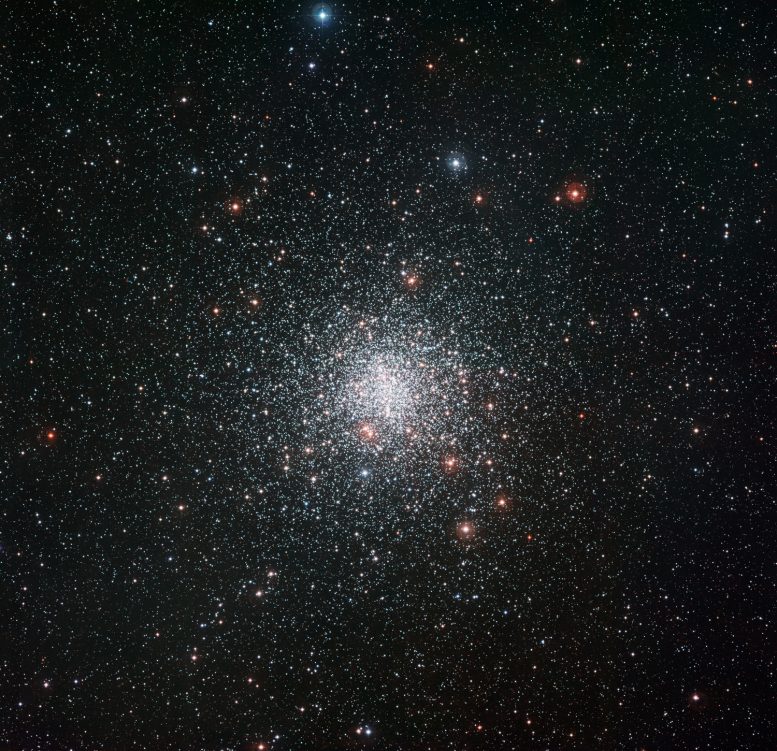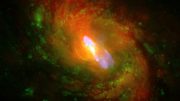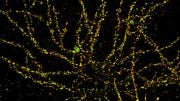
This image from the Wide Field Imager attached to the MPG/ESO 2.2-meter telescope at ESO’s La Silla Observatory shows the spectacular globular star cluster Messier 4. This great ball of ancient stars is one of the closest of such stellar systems to the Earth and appears in the constellation of Scorpius (The Scorpion) close to the bright red star Antares. Credit: ESO
Using the Wide Field Imager (WFI) on the MPG/ESO 2.2-meter telescope at ESO’s La Silla Observatory, astronomers captured a new image of globular star cluster Messier 4, which contains a strange lithium-rich star.
A new image from ESO’s La Silla Observatory in Chile shows the spectacular globular star cluster Messier 4. This ball of tens of thousands of ancient stars is one of the closest and most studied of the globular clusters and recent work has revealed that one of its stars has strange and unexpected properties, apparently possessing the secret of eternal youth.
The Milky Way galaxy is orbited by more than 150 globular star clusters that date back to the distant past of the Universe. One of the closest to the Earth is the cluster Messier 4 (also known as NGC 6121) in the constellation of Scorpius (The Scorpion). This bright object can be easily seen in binoculars, close to the bright red star Antares, and a small amateur telescope can show some of its constituent stars.
This new image of the cluster from the Wide Field Imager (WFI) on the MPG/ESO 2.2-meter telescope at ESO’s La Silla Observatory reveals many more of the cluster’s tens of thousands of stars and shows the cluster against the rich background of the Milky Way.
This video gives a close-up view of a new image from the Wide Field Imager attached to the MPG/ESO 2.2-meter telescope at ESO’s La Silla Observatory showing the spectacular globular star cluster Messier 4. This great ball of ancient stars is one of the closest such stellar systems to the Earth and appears in the constellation of Scorpius (The Scorpion) close to the bright red star Antares. Credit: ESO, Music: Disasterpeace
Astronomers have also studied many of the stars in the cluster individually using instruments on ESO’s Very Large Telescope. By splitting the light from the stars up into its component colors they can work out their chemical composition and ages.
New results for the stars in Messier 4 have been surprising. The stars in globular clusters are old and hence not expected to be rich in the heavier chemical elements .[1] This is what is found, but one of the stars in a recent survey was also found to have much more of the rare light element lithium than expected. The source of this lithium is mysterious. Normally this element is gradually destroyed over the billions of years of a star’s life, but this one star amongst thousands seems to have the secret of eternal youth. It has either somehow managed to retain its original lithium, or it has found a way to enrich itself with freshly made lithium.
This WFI image gives a wide view of the cluster and its rich surroundings. A complementary and more detailed view of just the central region from the orbiting NASA/ESA Hubble Space Telescope was also released this week as part of the Hubble Picture of the Week series.
Notes:
- Most of the chemical elements heavier than helium are created in stars and dispersed into the interstellar medium at the end of their lives. This enriched material then forms the building blocks of future stellar generations. As a result very old stars, such as those in globular star clusters, which formed before significant enrichment had occurred, are found to have lower abundances of the heavier elements when compared to stars, such as the Sun, that formed later.
Reference: “Detection of a Li-rich dwarf star: preservation or pollution?” by L. Monaco, S. Villanova, P. Bonifacio, E. Caffau, D. Geisler, G. Marconi, Y. Momany and H.-G. Ludwig, 13 March 2012, Astronomy & Astrophysics.
DOI: 10.1051/0004-6361/201117709









Be the first to comment on "Mysterious Lithium-Rich Star in Messier 4"